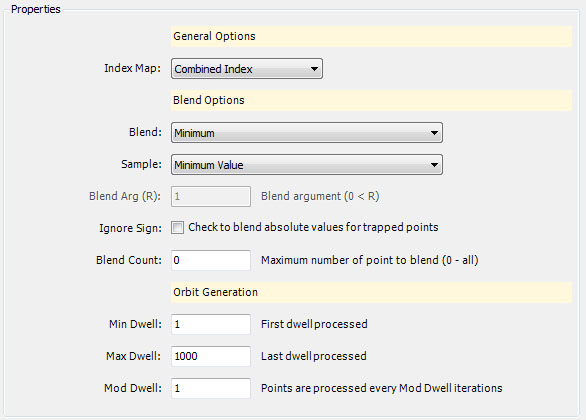
Alternate Mapping: Orbit Trap
The Fractal Science Kit fractal generator Alternate Mapping Orbit Trap defines the alternate value in terms of an orbit trap.
See also:
The Orbit Trap properties pages are:
These pages are as described for Orbit Trap. The only difference is that the Controllers page is omitted and the Properties page is added.
The Properties page supports several properties to control the results.

General Options
The alternate point's Index is set to the value given by Index Map. Index Map is one of the following:
- Combined Index
- Trap Index
- Trap Delta
- Trap Dwell
- Trap Count
- Dwell
Trap Index equates to trappedPoint.Index. Trap Delta equates to trappedPoint.Delta. Trap Dwell equates to the trapped point's dwell value. Trap Count is the number of traps that trapped the point. Dwell is the dwell of the underlying orbit point. In each case the trapped point in question is controlled by the Sample property described below.
Unlike these other settings, Combined Index is not useful for coloring. However, since the Combined Index combines the other index values to form a unique value and Index is used by Solid Guessing to determine if 2 samples are equal, differences in the index values will cause the samples to be seen as not equal, which will improve the visible results of Solid Guessing. So the recommendation is to use Combined Index for Index Map unless you need to use the index for coloring.
The alternate point's Angle is set to the trapped point's angle (trappedPoint.Angle).
Blend Options
The Blend Options section controls the strategy employed to blend the set of trapped points over the entire orbit into a single value.
Blend can be one of the following values:
- Minimum
- Sum
- Product
- Power Mean: -2
- Power Mean: -1 (Harmonic Mean)
- Power Mean: 0 (Geometric Mean)
- Power Mean: 1 (Arithmetic Mean)
- Power Mean: 2 (Quadratic Mean)
- Lehmer Mean: -2
- Lehmer Mean: -1
- Lehmer Mean: 0 (Harmonic Mean)
- Lehmer Mean: 1 (Arithmetic Mean)
- Lehmer Mean: 2 (ContraHarmonic Mean)
- Generalized Mean: f(x) = (x+R)/(x-R)
- Generalized Mean: f(x) = (R-x)/(x+R)
- Generalized Mean: f(x) = 1/(R+x)+1/(R-x)
- Generalized Mean: f(x) = x/(R+x)-x/(R-x)
- Generalized Mean: f(x) = Sin(R*x)
- Generalized Mean: f(x) = Cos(R*x)
- Generalized Mean: f(x) = Tan(R*x)
- Generalized Mean: f(x) = Cot(R*x)
- Generalized Mean: f(x) = Sec(R*x)
- Generalized Mean: f(x) = Csc(R*x)
- Generalized Mean: f(x) = Sinh(x)
- Generalized Mean: f(x) = Csch(x)
- Generalized Mean: f(x) = Log(x)
- Generalized Mean: f(x) = Exp(x)
- Variance
The simplest (and default) Blend is Minimum. This uses the minimum trap value of all the trapped points. Sum and Product simply return the sum and product of the values for all trapped points, respectively. The Power Mean, Lehmer Mean, and Generalized Mean settings return the named mean over all the trapped point values. Variance returns the variance of all trapped point values. The symbol R in some of the names above indicates the blend algorithm requires an argument which is given by Blend Arg (R).
If Ignore Sign is checked, the blend is applied to the absolute value of the trapped point values.
Blend Count is used to limit the number of trapped points to process. If Blend Count is 0, then all the trapped points are processed. Otherwise, only the Blend Count trapped points with the smallest values (absolute value) are processed.
For details about Power Mean, Lehmer Mean, or the Generalized Mean, see the following:
Eric W. Weisstein. "Power Mean."
From MathWorld--A Wolfram Web Resource.
Eric W. Weisstein. "Lehmer Mean."
From MathWorld--A Wolfram Web Resource.
From Wikipedia, the free encyclopedia.
As described above, the Blend setting determines how the value is computed. The angle and index are taken directly from one of the trapped points. The Sample property determines the method used to choose which one. The Sample property can be set to one of:
- Minimum Value
- Maximum Value
- Minimum Delta
- Maximum Delta
If Sample is Minimum Value, the trapped point associated with the minimum value (absolute value) is used. If Sample is Maximum Value, the trapped point associated with the maximum value (absolute value) is used. If Sample is Minimum Delta, the trapped point whose value is closest to the resulting blended value is used. If Sample is Maximum Delta, the trapped point whose value is farthest from the resulting blended value is used.
Orbit Generation
The Orbit Generation section defines 3 properties: Min Dwell, Max Dwell, and Mod Dwell. These values control the set of orbit points that are considered when processing the orbit. Min Dwell is the 1st dwell to check. Max Dwell is the last dwell to check. Mod Dwell - 1 is the number of dwells to skip between checks. That is, a dwell is processed if the dwell is between MinDwell and MaxDwell inclusive, and (dwell - MinDwell) % ModDwell = 0.